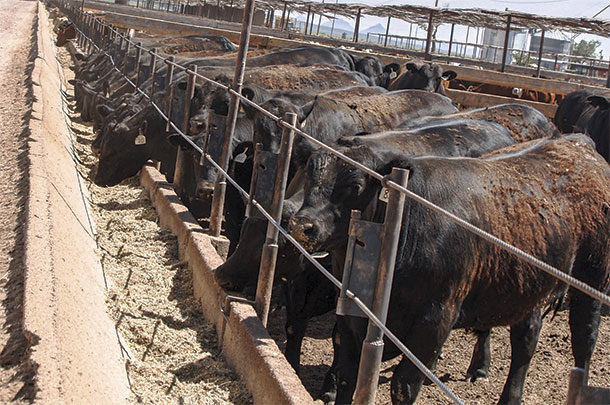We also know much of this loss occurs in cattle after they have been on feed for some period. With the industry’s greater abilities to keep newly received cattle alive, there is a growing belief the damage done to lung and other tissues comes back to haunt us after the cattle have been on feed for some time, especially as they are kicked up to the high-starch, high-energy finishing rations. Additionally, increased questions have developed concerning the variation of immune status in newly received cattle.
In general, we know the majority of death loss is caused by bovine respiratory disease (BRD). Bovine respiratory disease is an endemic and one of the most common and costly diseases in commercial North American feedlots and has been for years. We also know that BRD treatment costs have increased dramatically. In 2011, the National Animal Health Monitoring System (NAHMS) beef feedlot study reported that the direct cost of treatment of respiratory disease in feedlot cattle was $23.60 per case, nearly double the reported cost in 1999 of $12.59 per case. Other reports have indicated that most of the increases in mortality have come about over the last four to five years.
A variety of reasons have been given for this increase and have ranged from less expensive grain markets prompting the starting of lighter cattle, to the reduced availability of beef leading to the feeding of cattle to heavier weights, to the challenges in finding and maintaining experienced labor for the health management of the incoming animals. All of these are valid reasons.
Let’s explore a few other possibilities that are well known but may not have the simplest solutions.
It starts at birth, or before
Based on the 2017 Census of Agriculture, the average cow herd size in the U.S. is 43.5 head. This means the typical calf entering the feedyard is likely to come from a very small operation. Many of these operations are very well managed but, unfortunately, many are not. If we start at the transition point and work backward to the farm of origin, we find calves produced in enormously varying conditions, particularly when it comes to nutrition programs ranging all the way back to conception. The immune system of the calf, which is critical at all stages of life, but particularly as it is weaned and goes through transition to the feedyard, is established during fetal development.
For instance, studies have shown that calves born to cows fed a diet lacking in protein early in pregnancy may be more susceptible to respiratory disease later in life, particularly as they enter the feedyard. This is believed to be caused by depressed development of the immune system and poor lung development in the fetus during gestation. Per discussions above, 15%-45% of cattle have been affected by BRD and 1%-5% (likely higher) of cattle placed in feedlots die from this disease. There is likelihood that fetal programming, through proper nutrition, can help reduce the incidence of BRD in these cattle.
This will become increasingly important as the industry’s access to antibiotics becomes more restricted. Protein and energy are not the only critical nutrients to development of a competent immune response at this stage of development. Mineral nutrition is also highly involved. Chirase and Greene (2001) reported that sources of zinc (Zn) and manganese (Mn) were important during gestation, calf growth after birth, and during the transition and starting phases of young cattle. Feeding available sources of Zn and Mn increased dry matter intake as well as reduced the incidence of respiratory-related morbidity and mortality in cattle entering the feedyard.
The problem
As related above, most cattle entering the feedyard, especially through typical auction facilities, come from one of many small cattle operations. This means the nutritional background of these calves, from gestation on, is incredibly variable. A truckload of 80 calves could have 80 different nutritional and immune response backgrounds.
The potential lack of a sound immune system may then be coupled with:
- Weaning stress (weaning that occurs on the truck from the farm to the auction barn)
- Water and feed deprivation resulting in significant shrink
- Further transportation
- Handling and processing stress (including dehorning, castration, branding and multiple vaccinations)
- Exposure to various pathogenic organisms to which they have no or limited immunity
This is all then combined to produce a load of calves with varying immunocompetence arriving at the door of the feedyard, or at least the next production stage, with a stage soundly set for morbidity, and worst case, extensive mortality.
Circling back, we find a significant problem resides on the cow-calf operations, particularly with highly variable nutritional programs from conception on that fail to support the establishment and support of a sound immune response in calves. But along with this comes the management practice by many producers of weaning calves by simply pulling them off the cow and hauling them to the auction.
This understanding has initially created a need for the preconditioning industry. This comes either in the form of specific operations focused on the process or special sales programs for preconditioned calves that have been previously weaned (generally a minimum of 45 days pre-sale) and to whom a specified set of processes have been administered (vaccinations, deworming, castration, dehorning). They are also required to “train” these cattle to eat from a feedbunk and/or trough and to drink from a waterer.
One potential problem with many of these programs is that while all the “health-related” components are specified, the nutrition program often is not. Producers are directed to teach cattle to eat from a trough, but no specification is given to the feed itself. No levels of protein, energy, minerals and vitamins are indicated. As noted previously, these nutrients are very specific to the support of immune function. This is likely a reason why some preconditioning programs, while helpful, still allow for considerable morbidity and mortality in incoming calves.
The issue then becomes, if the cow-calf operation has used a less-than-optimal nutrition program, the preconditioning process will work best if those calves are fed a diet that will adequately support immune response and help minimize stress effects during transition. In other words, a diet that will bring the animal to 100% immune function, or close to it, as quickly as possible.
How long?
Questions have arisen as to what this time frame needs to be. What is the correct duration of the preconditioning period? The industry standard is 45 days. However, this has been questioned. Studies by Kansas State have indicated a precon period of 15 days can be as effective as those 30 days or longer. Oklahoma State reported superior results when cattle were preconditioned over 30 days. The Texas A&M Ranch to Rail data suggested 45. More recently, multisourced data is indicating 60 days may be the most effective. At this stage, there is no definitive answer, and the actual period should probably be dictated by the animals and the circumstances (animals themselves, sources, how they were weaned, environmental conditions, etc.)
Labor – always an issue
All the ag (and other) industries can attest that location and retention of good labor is their number one challenge. While hiring quality pen riders and hospital staff has always been difficult, it has reached a critical stage in recent years. Many yards are finding it difficult to attract and retain quality staff, particularly those with experience and abilities to deal with sick cattle and, more importantly, identifying cattle just before they become sick.
Part of this is related to the overall low unemployment numbers common in the U.S. today. This is related to competition with other industries, many of which historically pay better, even though feedyard salaries have been increasing over recent years. Another challenge is that the work is hard, subject to the environment and, in many cases, dangerous. Finding that person who is familiar with cattle and who has the eye for spotting one the day before it spikes a fever is increasingly difficult.
Conclusion
Death loss in the feedyard is expensive and causes the loss of tons of beef products that could enter the food chain. To meet the growing demand for beef in the world, understanding and resolving the causes of this loss is necessary and critical. But handling the issues is not only for the feedyard industry alone. It will require the involvement of all phases all the way back to breeding. ![]()
PHOTO: Several factors explain the rising risk of death loss in feedlots, and the connection to many of them could begin with seedstock genetics and nutritional intake. Photo by Sal Gomez.
References omitted but are available upon request. Click here to email an editor.
Dr. Steve Blezinger is a management and nutritional consultant with an office in Sulphur Springs, Texas. Email Steve Blezinger or call (903) 352-3475. Follow him on Facebook at Reveille Livestock Concepts.

-
Stephen B. Blezinger
- Reveille Livestock Concepts
- Sulphur Springs, Texas
- Email Stephen B. Blezinger












